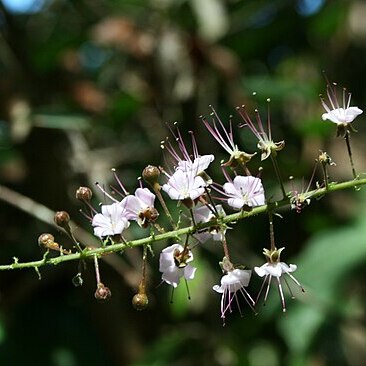Shrubs or trees with alternate, simple, entire leaves. Flowers in axillary and terminal panicles or racemes; hypanthium short and symmetrical or elongated and then usually gibbous, the lobes 5, reflexed; petals 5; stamens 3-7 (rarely more), inserted at the summit of the hypanthium disk, usually unilaterally inserted (i. e. on the side where the ovary is attached, opposite the style and the enlarged side of the hypanthium); ovary unilocular, hirsute, attached to the side of the hypan-thium-tube above the base (i. e. below the base of the middle stamen); style basal. Fruit drupaceous, often dry.
Inflorescence many-flowered, usually a lax raceme or an elongate thyrse with patent flowers or lateral branches; the latter usually bear several sterile bracts and end in a single flower or a few cymosely arranged flowers.
Stamens 3–9; filaments laxly undulate in bud with a single undulation, inserted on abaxial surface of disk (at least in our area), far-exserted, usually much longer than the combined length of calyx and receptacle-tube.
Drupe with exiguous mesocarp and smooth, thin, hard, non-granular endocarp with 4–7 longitudinal shallow channels which represent lines of weakness that permit the seedling to escape.
Receptacle-tube subcampanulate to narrowly cylindric, slightly gibbous, usually shorter than the sepals, usually glabrous inside except near the throat, and hairy outside.
Ovary monocarpellary, 1-locular, usually inserted at mouth of receptacle-tube, style filiform, far-exserted.
Lower leaf surface glabrous or with a few strigose or strigulose hairs.
Bracts and bracteoles often with stalked or sessile glands.
Sepals 5, subequal, usually spreading or reflexed.
Germination hypogeal, first leaves alternate.
Petals 5, shorter than the sepals.
Flowers slightly zygomorphic.
Staminodes short, free.
Trees or shrubs.

